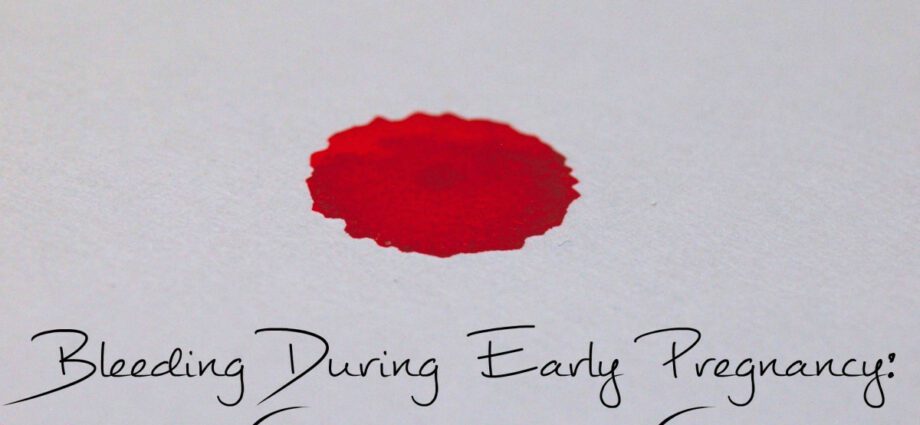Contents
Spotting: all about bleeding during pregnancy
At the start of pregnancy, it is not uncommon to have spotting, that is to say small bleeding, without it being serious. At any stage of pregnancy, however, it is important to consult with any bleeding in order to detect a complication requiring rapid treatment as early as possible.
What is spotting?
Light vaginal bleeding is called spotting. They can take place during the cycle, but also during pregnancy, most often in the first trimester, when pregnancy sets in.
Causes of bleeding in early pregnancy
1 in 4 pregnant women would have bleeding in the first trimester of pregnancy. These metrorrhagia at the start of pregnancy can have different causes, and therefore different consequences on the rest of the pregnancy.
- implantation bleeding : When the egg implants in the uterine lining (about 7-8 days after fertilization), very light bleeding may occur. They are benign and have no effect on the good progress of the pregnancy.
- an ectopic pregnancy (EGU) : instead of implanting and developing in the uterine cavity, the egg develops outside, usually in the fallopian tube, more rarely in the ovary, in the abdominal wall or in the cervix. GEU usually manifests as blackish blood loss which may occur before the due date of your period (and may be mistaken for a period), followed by severe pain in the lower abdomen. GEU is not an active pregnancy, and it must be managed quickly with medication or surgery to prevent the tube from being permanently damaged.
- a miscarriage : this spontaneous termination of pregnancy which affects 15% of pregnancies on average, is generally manifested by blood loss accompanied by pain in the lower abdomen, more or less late in the course of the first trimester. Sometimes the product of pregnancy is eliminated naturally; in other cases drug therapy or aspiration will be necessary.
- a decidual hematoma (or partial placental abruption): at the time of implantation, the trophoblast (future placenta) may detach a little and cause the formation of a hematoma which can lead to small brown bleeding. The hematoma usually resolves spontaneously, with no effect on the progress of the pregnancy. Sometimes, however, it gradually gets worse and ends in a miscarriage.
- molar pregnancy (or hydatidiform mole): relatively rare, this complication is due to a chromosomal abnormality. It is characterized by abnormal development of the placenta in the form of cysts and the absence, 9 times out of 10, of the embryo. Pregnancy is therefore not progressive. In its typical form, molar pregnancy is manifested by fairly significant bleeding responsible and an increase in the volume of the uterus, sometimes with an accentuation of the signs of pregnancy. In other cases, it leads to a spontaneous miscarriage.
Finally, it happens that a small bleeding occurs at the level of the cervix, after a vaginal examination or sexual intercourse.
Birthdays rules
When bleeding occurs on the due date of your period after the pregnancy has started, it is called a “birthday period”. This is a minor bleeding that does not cause any pain.
We do not know exactly the cause of these “birthday rules” which are, moreover, rare. It may be a small so-called decidual hematoma; small bleeding due to implantation; a slight hormonal imbalance which leads, the first 2-3 months of pregnancy to light bleeding on the anniversary date of the rules, without this impacting the evolution of the pregnancy.
More serious causes of vaginal bleeding during pregnancy
In early pregnancy, the most serious causes of bleeding are miscarriage, ectopic pregnancy, and molar pregnancy, all of which lead to pregnancy termination.
In late pregnancy, the most serious cause of bleeding isretro-placental hematoma (not to be confused with decidual hematoma). Sometimes in the third trimester, the placenta peels off over a more or less extensive part. This “premature detachment of a normally inserted placenta” will lead to the formation of a hematoma between the wall of the uterus and the placenta. Sudden pelvic pain, contractions, bleeding then appear.
The retro-placental hematoma is an obstetric emergency because the survival of the baby is at stake. The placenta no longer plays its nourishing role correctly (in terms of oxygen and nutrients), the baby is in fetal distress. The mother is in danger of bleeding. A cesarean section is therefore performed urgently.
Expectant mothers with hypertension or gestational diabetes are more likely to have a retro-placental hematoma. A violent impact on the stomach can also cause this type of hematoma. But sometimes, no cause is found.
The other possible cause of bleeding in late pregnancy is preliminary cake, that is, an abnormally low inserted placenta. Under the effect of contractions at the end of pregnancy, the placenta can peel off one part and cause more or less significant bleeding. It is essential to consult in order to control the placenta. Absolute rest will be essential until childbirth, which will take place by cesarean section if it is a covering placenta previa (it covers the cervix and therefore prevents the passage of the baby).
What to do in case of spotting in early pregnancy?
In principle, all bleeding should lead to consultation during pregnancy.
At the start of pregnancy, the gynecologist or midwife will generally prescribe a blood test for the hormone bHCG as well as an ultrasound to ensure that the pregnancy is progressing well.










